|
|
|
Sort Order |
|
|
|
Items / Page
|
|
|
|
|
|
|
| Srl | Item |
| 1 |
ID:
113895


|
|
|
|
|
| Publication |
2011.
|
| Summary/Abstract |
In this introduction, we outline the general conceptual framework that ties the various contributions to this special issue together. We argue for the importance of anthropology to "take on" mobility and discuss the advantages of the ethnographic approach in doing so. What is the analytical purchase of mobility as one of the root metaphors in contemporary anthropological theorizing? What are the (dis)advantages of looking at the current human condition through the lens of mobility? There is a great risk that the fast-growing field of mobility studies neglects different interpretations of what is going on, or that only patterns that fit the mobilities paradigm will be considered, or that only extremes of (hyper)mobility or (im)mobility will be given attention. The ethnographic sensibilities of fieldworkers who learn about mobility while studying other processes and issues, and who can situate movement in the multiple contexts between which people move, can both extend the utility of the mobilities approach, and insist on attention to other dynamics that might not be considered if the focus is first and last on (im)mobility as such. In this special issue, we do not want to discuss human mobility as a brute fact but rather analyze how mobilities, as sociocultural constructs, are experienced and imagined.
|
|
|
|
|
|
|
|
|
|
|
|
|
|
|
|
| 2 |
ID:
144353
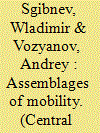

|
|
|
|
|
| Summary/Abstract |
This article addresses reconfigurations of urban space in Central Asia through the lens of marshrutka mobility. Marshrutka-based transport is – together with the bazaar trade – a major sector of Central Asian economy. Although precise data are not available, estimates propose that one family in ten gains its income through it. In spite of its economic and social importance, there has barely been any research on marshrutka mobility so far. The marshrutka mobility phenomenon appears at once wide-ranging and elusive. In order to grasp its complexity, we propose a theory framework based on John Law's concept of fluidity and assemblage. Providing empirical insights from Khujand, in northern Tajikistan, the article addresses marshrutka mobility from a local perspective, notably with regard to regulatory processes of marshrutka-based transport. It also covers the trans-local perspective, with particular attention to global flows of ideas, vehicles, and people.
|
|
|
|
|
|
|
|
|
|
|
|
|
|
|
|
| 3 |
ID:
187629


|
|
|
| 4 |
ID:
144356
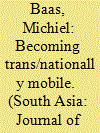

|
|
|
|
|
| Summary/Abstract |
The growth of Indian students' enrolment numbers in Australian educational institutions has often been linked to the relatively easy pathway the country, until recently, offered towards Australian permanent residency (PR). However, building on ethnographic data collected over the past ten years this article shows that ‘permanently’ residing in Australia is often not the objective. Instead, the mobility that these Indian student-migrants aim for encompasses a broader understanding of mobility that includes a variety of locations in both countries and beyond which emerge and/or are abandoned organically in an individual's trajectory. As such it is argue that their mobility strategies can be conceptualized as having ‘trans/national’ dimensions.
|
|
|
|
|
|
|
|
|
|
|
|
|
|
|
|
| 5 |
ID:
114034


|
|
|
|
|
| Publication |
2012.
|
| Summary/Abstract |
The authors discuss improvements in the Russian troops' combat gear and show ways to be followed in research to design soldiers' combat gear for the 21st century.
|
|
|
|
|
|
|
|
|
|
|
|
|
|
|
|
| 6 |
ID:
191700
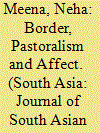

|
|
|
|
|
| Summary/Abstract |
The demarcation of the India–Pakistan border on the western side of Rajasthan in 1947 had profound implications for the pastoral communities there. Based on an archival history of the Thar desert and ethnographic fieldwork in the border villages of Rajasthan, this paper explores how pastoralists interact with the border and the bordering practices of the state. Focusing on the Raika community, the paper examines how borders impact the mobility, identity and traditional life of the pastoralists. Building on Raika memories of mobility and connections across the border, the paper argues that the interactions of the pastoralists maintain an affective relationship with this war and violence affected borderland, despite the administrative practices of surveillance, border maintenance and developmental projects that have produced an environment of insecurity and uncertainty.
|
|
|
|
|
|
|
|
|
|
|
|
|
|
|
|
| 7 |
ID:
072726
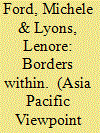

|
|
|
|
|
| Publication |
2006.
|
| Summary/Abstract |
The border studies literature makes a strong case against claims for unfettered transnationalism and 'borderlessness' in our 'globalising world'. However, its focus on movement across borders means that it fails to address bordering practices that occur within the nation-state as a result of transnational activity. In this paper, we extend Cunningham and Heyman's concepts 'enclosure' and 'mobility' to confront the different layers of bordering (both physical and non-physical) that have occurred in Indonesia's Riau Islands since they became part of the Indonesia-Malaysia-Singapore Growth Triangle.
|
|
|
|
|
|
|
|
|
|
|
|
|
|
|
|
| 8 |
ID:
173176
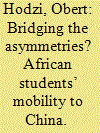

|
|
|
|
|
| Summary/Abstract |
African students’ mobility to China is growing – making China the second most popular destination for African students studying abroad, after France. Generally, due to the pervasive poverty and inequality in African states, educational mobility is a means to escape individual socio-economic challenges for the transformation of lives. However, is the African students’ mobility to China able to achieve those expectations? Through a critical analysis of current scholarship in African student education mobility the paper explores the underlying material and ideational motivations of China’s education support in Africa. In probing Africans’ educational mobility to China, the paper pushes the boundaries of enquiry beyond the surface of affordable education. Examining the asymmetries emerging from African students’ mobility to China and questioning the bridging effect of educational mobility, the paper finds that education aid and development in Africa have always been a factor of external powers’ domestic and foreign interests.
|
|
|
|
|
|
|
|
|
|
|
|
|
|
|
|
| 9 |
ID:
178756
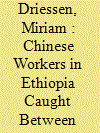

|
|
|
|
|
| Summary/Abstract |
Ever since Beijing has sought to fuel domestic growth through Chinese-led development overseas—first under the aegis of Jiang Zemin’s Going Out Policy and more recently as part of Xi Jinping’s Belt and Road Initiative—thousands of Chinese have moved overseas for work. Africa has been one of the destinations of Chinese companies and their expatriate staff. Although we have learned a great deal about China’s mega-projects across the African continent, little is known about the certified engineers and experienced builders who carry them out. What brings them to Africa? And, more importantly, what makes them stay for years on end, even if they wish to return to China? In this article I zoom in on the lives of Chinese men employed in Ethiopia’s construction industry to show how three decades of domestic growth in China has pushed workers overseas, while jeopardizing their return. Workers’ lives are marked by double displacement. They are not only isolated from local African communities through a dormitory labour regime that controls their time and limits their mobility, but also, more importantly, they are displaced from social life in China. Domestic development has at once increased aspirations and made them harder to obtain, especially for men, who are expected to fulfill the promise of upward social mobility for themselves and their families. In order to realize aspirations and meet social expectations related to social reproduction, geographic mobility has become a necessity for men who cannot rely on family wealth or connections, forcing them into a state of suspension.
|
|
|
|
|
|
|
|
|
|
|
|
|
|
|
|
| 10 |
ID:
143651
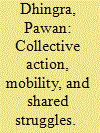

|
|
|
|
|
| Summary/Abstract |
The model minority remains one of the most durable images assigned to immigrant groups despite ample critiques of it. Those persons considered to be a model minority often promulgate the myth themselves. Common arguments against the stereotype do not effectively speak to these people. In this article I demonstrate the disconnect between the critiques of the stereotype and the views of Indian American professionals, a group widely considered to be a model minority. I then offer an alternative approach to dismantling the stereotype that can resonate more with those invested in it. This approach highlights groups’ history of collective action in response to racialised and class obstacles. Three case studies illustrate this approach: study of Indian American motel owners, of physicians, and of taxi drivers. Taxi drivers are thought to be on the opposite end of the model minority binary than doctors and successful motel owners. The case studies highlight the grassroots activism shared by all three groups.
|
|
|
|
|
|
|
|
|
|
|
|
|
|
|
|
| 11 |
ID:
108325


|
|
|
|
|
| Publication |
2011.
|
| Summary/Abstract |
This article explores mobility transitions in Thailand through the particular experience of two villages in Northeast Thailand over the period from the early 1980s through to 2009. The authors show through the mobility histories of Ban Non Tae and Ban Tha Song Korn that, while rural settlements may have always had a greater degree of mobility than the sedentary peasant paradigm suggests, important changes have taken place over the last quarter of a century in how that mobility is manifested. Personal mobility has increased; the migration of women has become as prevalent as that of men; and a mixture of daily commuting and more permanent moves have replaced seasonal circulation. In the process, mobility has created complex, multi-sited households; has led to a growing geriatrification of farming; and has altered the basis for livelihood sustainability and village resilience. Case studies of two individuals highlight these dynamics and add color to the themes the authors present. In making clear households' changing spatial signatures, the authors also seek to show how national and international development processes are imprinted in village and household histories.
|
|
|
|
|
|
|
|
|
|
|
|
|
|
|
|
| 12 |
ID:
137928
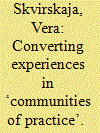

|
|
|
|
|
| Summary/Abstract |
This article looks at ‘educational’ migration instigated by the Danish programme of agricultural apprenticeships, which since the late 1990s has brought many young Ukrainians to rural Denmark. It discusses discrepancies between the logic of achievement implied by the programme’s ideology on the one hand, and Ukrainian apprentices’ aspirations to social mobility on the other hand. In this way, the article questions the concept of ‘community of practice’ that has been used to describe the formation of a social persona sharing the values of this community. Using ethnographic case studies of former apprentices, I argue that while apprenticeships often fail to produce a shared social and professional identity within a community of practice, there are many ways in which the experiences afforded by Danish apprenticeships lead to (sometimes unforeseen) achievements.
|
|
|
|
|
|
|
|
|
|
|
|
|
|
|
|
| 13 |
ID:
152792
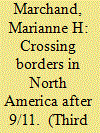

|
|
|
|
|
| Summary/Abstract |
This article is part of a larger project on ordinary border crossings and state practices in North America. The changing border governmentalities in the region focusing on securitising their borders against potential terrorist threats and the increased emphasis on the managing of population flows have led to a reduced mobility for certain travellers as opposed to others. The construction of potentially safe and ‘un-safe’ subjects through profiling on the basis of race, ethnicity, national origin, gender, religion and socioeconomic background and the increasing use of biometrics have impacted upon travellers’ mobilities. In the North American context, the Mexican state has undergone significant modernisation in terms of its border control capacities, thus enhancing not only its capacity as a buffer state, but also its performative sovereignty, and is therefore an interesting case to study. This article aims to analyse how these transformations in border governmentalities have affected the mobility of ‘ordinary’ travellers, and how they have developed coping strategies and resistances towards the potential curbing of their respective mobilities.
|
|
|
|
|
|
|
|
|
|
|
|
|
|
|
|
| 14 |
ID:
143545
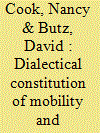

|
|
|
|
|
| Summary/Abstract |
This paper contributes to the critical mobilities literature by analysing local mobilities in Gojal, northern Pakistan in the aftermath of the 2010 Attabad Landslide, in order to develop new insights regarding the dialectical relationship between mobility and immobility. The landslide destroyed a large section of the Karakoram Highway, the region's arterial roadway. Among its disastrous effects was prolonged disruption of the accustomed movements of 20,000 villagers stranded north of the slide. To show how mobility is constituted dialectically in relation to immobility in this context, we detail the social and economic demobilisations Gojalis faced when the highway became impassable, and outline new mobilities they developed to mitigate the disaster of protracted strandedness. Gojalis responded to demobilisation by remobilising, at different scales, along new routes, in different directions and via new mobility platforms, thereby re-establishing circulation as a paradigm of everyday life and demonstrating the paper's argument that disasters are social processes that have simultaneously demobilising and remobilising effects. We conclude that nurturing a multiplicity of mobile relations and practices in several directions and across scales during the disaster recovery process will help Gojalis avoid a similar mobility disaster in the future.
|
|
|
|
|
|
|
|
|
|
|
|
|
|
|
|
| 15 |
ID:
154906
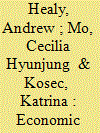

|
|
|
|
|
| Summary/Abstract |
We consider the thesis of Alexis de Tocqueville (1856) that economic development and increased mobility may generate political discontent not present in more stagnant economies. For many citizens, as they become aware of the potential for improved living standards, their aspirations may increase faster than actual living standards. Expanded opportunity may then paradoxically result in dissatisfaction with government rather than greater confidence. We develop a formal model to capture Tocqueville’s (1856) verbal theory and test its predictions using a 2012–2013 face-to-face survey experiment conducted in Pakistan. The experiment utilizes established treatments to subtly manipulate either a participant’s perceptions of her own economic well-being, her perceptions of society-wide mobility, or both. As predicted by the theory, political discontent rises when declining personal well-being coincides with high mobility to create unrealized aspirations. The results thus identify the conditions under which expanded economic opportunity can lead to political unrest.
|
|
|
|
|
|
|
|
|
|
|
|
|
|
|
|
| 16 |
ID:
027376
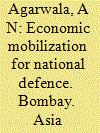

|
|
|
|
|
| Publication |
Bombay, Asia Publishing House, 1966.
|
| Description |
xi, 126p.
|
|
|
|
|
|
|
|
|
|
|
|
Copies: C:1/I:0,R:0,Q:0
Circulation
| Accession# | | | | | | | | | | | |
| 000453 | 355.033054/AGA 000453 | Main | On Shelf | General | | | | | | | |
|
|
|
|
| 17 |
ID:
183178


|
|
|
|
|
| Summary/Abstract |
In the context of larger discussions of how education, employment opportunities and social mobility processes intersect, this article presents micro-evidence to interrogate the role of higher education in accessing avenues for mobility regarding employment opportunities for educated youth in India’s rural Punjab. By presenting their career ambitions and trajectories, this fieldwork-based article maps a plethora of dynamics influencing the individual journeys. The article reflects on how social capital, caste and economic marginality affect the career options and mobility potential of these young males and females. The findings reaffirm that caste, compounded by economic inequality, tends to inhibit paths to upward mobility for young people located at the lower end of traditional hierarchies. However, determined efforts by many disadvantaged young rural people to succeed, partly supported by targeted affirmative action programmes, are also showing some remarkable results that offer hope.
|
|
|
|
|
|
|
|
|
|
|
|
|
|
|
|
| 18 |
ID:
185527
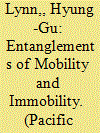

|
|
|
| 19 |
ID:
165970
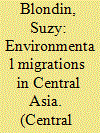

|
|
|
|
|
| Summary/Abstract |
Increasingly, studies are considering Central Asia a ‘hot spot’ of climate change and a region prone to environmental migrations. Growing aridity and the shrinking of glaciers may have important impacts on food security, health, human security and infrastructure in the region and compel people to move. Drawing on the literature on environmental issues in Central Asia and on interviews conducted in the Kuhistoni-Badakhshan Autonomous Region of Tajikistan, this article provides a literature survey on environmental migrations in the region and positions Central Asia in the current debates within the broad environmental migrations literature. The article shows that environmental issues can stand out as an important push factor for out-migration in Central Asia, highlights the important role of the Soviet heritage of environmental management as well as of post-Soviet socio-economic transformations in understanding these issues, and discusses possible adaptation strategies.
|
|
|
|
|
|
|
|
|
|
|
|
|
|
|
|
| 20 |
ID:
178038
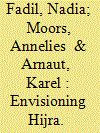

|
|
|
|
|
| Summary/Abstract |
Within the current Western European context, where the presence of Islam in the public sphere has become an object of continuous polemics and debates, emigrating or ‘leaving Europe’ has emerged as a conceivable option among a wide range of people who identify as Muslim. Both within and beyond specific pious circles such migratory moves have sometimes been framed as hijra. This special issue enquires into the way hijra is imagined and experienced, but also how the issue of hijra is debated and acted upon among European Muslims who are contemplating the possibility of leaving Europe, or who have already left the continent. In order to cover both the specific and the more general dynamics surrounding hijra, this thematic issue is motivated by one, albeit multi-layered hermeneutical objective. In general terms, we aim to understand the complex and multiple significations operating around the notion of hijra among European Muslims of various backgrounds and convictions. In so doing we seek to contribute to the mounting anthropology of Islam in Europe by examining articulations of mobility and migration through religious imaginaries and repertoires. This implies ethnographically accounting both for the perspectives and assessments of those who are situated and located in Europe and desire to leave the continent in order to perform the hijra, as well as for the ways in which hijra is lived and practiced by those who have left Europe and moved to a Muslim-majority context. In order to buttress further the emerging anthropological field at the nexus of religion and mobility/migration, this introduction cautiously maps out a number of analytical concepts which we think could strengthen the multifaceted ethnographic ventures of the contributions comprising this thematic issue: the ‘ethics of dwelling’, ‘regimes of mobility/diversity’ and religious imaginaries and repertoires, being the most prominent.
|
|
|
|
|
|
|
|
|
|
|
|
|
|
|
|
|
|
|
|
|